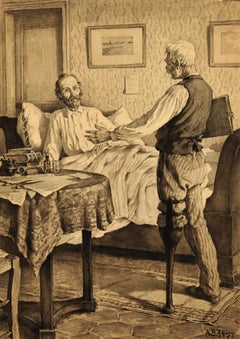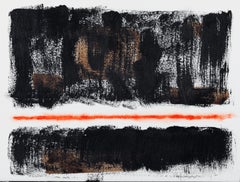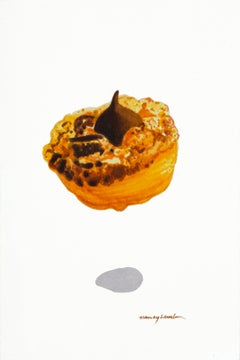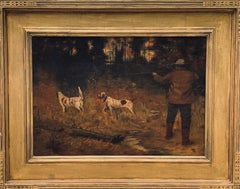Arthur Burdett Frost Paintings
American, 1851-1928
A famous illustrator and sporting artist, Arthur B. Frost is perhaps best known for his illustrations for the Uncle Remus tales by Joel Chandler Harris, as well as for naturalistic hunting and shooting prints. Many consider him to be the best illustrator of rural America.
An ardent sportsman himself, many of Frosts favorite subjects were hunting, fishing, and golfing. Often his golfing subjects tended towards humor. His scenes capture the drama of the sport - a hunter poised to shoot and a dog on point - with elements often integrated into a richly detailed woodland or marsh setting.
Frost chronicled aspects of America's cultural life for over five decades. From the late 19th to the early 20th centuries, his art appeared in the many books and publications of the time, including Harper's Weekly, Scribner's, and Life magazines.
Frost's illustrations always evoked the essence of a setting and its mood, whether depicting the hilarious escapades of the family cat or farm dog, or the serene pastoral lifestyle of the native northeast. His sound draftsmanship was combined with an intimate knowledge of nature. Frosts details in his pictures were very specific, as though drawn on the spot, and done in a very convincing manner. In the preface and dedication by Harris of his book Uncle Remus, Harris wrote of Frost "you have conveyed into their quaint antics the illumination of your own inimitable humor, which is as true to our sun and soil as it is to the spirit and essence of the matter. The book was mine, but now you have made it yours, both sap and pith" Other well known examples of Frosts illustrations are Brer Fox and Brer Rabbit from The Tar Baby.
Frost was known to have spent time in the art colony of Rockport, on the Eastern Shore of Cape Ann, Massachusetts, where he is said to have gone because of painter Gilbert Tucker Margeson.
He also summered at the noted Shinnecock Hills Summer School of Art, which William Merritt Chase set up a few miles west of Southampton, New York. Shinnecock Hills became the best known of all the out-of-doors summer art schools that developed in America during the late nineteenth century, and attracted hundreds of aspiring young men and women, including Frost, Rockwell Kent, Lydia Field Emmet, and many others.
Frost was red-green color blind, but it was not a great handicap since the majority of his work was reproduced in black and white. He managed to work successfully in color by reading the labels on the tubes and placing the colors in the proper order on his palette.
Arthur Frost is the father of impressionist painter John Frost (b. 1890 in Philadelphia - 1937), and as a young man John studied art with his father before going on to study in Europe.(Biography provided by Lincoln Glenn)
to
3
2
2
1
2
1
Overall Height
to
Overall Width
to
3
3
1
1
1
1
1
1
1
1
2
1
8
916
650
639
610
2
2
1
1
1
Artist: Arthur Burdett Frost
Workers Loading Freight Train
By Arthur Burdett Frost
Located in Fort Washington, PA
Image of workers loading barrels in a train yard.
Signed Lower Left.
Arthur Burdett Frost was our best illustrator of rural America. He usually treated his characters with humor, and in his drawings there was a directness and honesty which showed his sympathetic understanding of his subjects. His sound draughtsmanship was combined with an intimate knowledge of nature. The details in his pictures are always very specific, as though drawn on the spot, and so artfully chosen and placed as to carry out the picture’s idea in a natural and entirely convincing manner.
He may be best remembered now, however, for his charming illustrations for the Uncle Remus...
Category
Early 1900s Other Art Style Arthur Burdett Frost Paintings
Materials
Gouache, Watercolor
Men Reading the Newspaper
By Arthur Burdett Frost
Located in Fort Washington, PA
Story illustration, image of a man reading the newspaper surrounded by other men.
Arthur Burdett Frost was our best illustrator of rural Ameri...
Category
19th Century Other Art Style Arthur Burdett Frost Paintings
Materials
Watercolor
The Peg Legged Man
By Arthur Burdett Frost
Located in Fort Washington, PA
The Peg Legged Man
Arthur Burdett Frost was our best illustrator of rural America. He usually treated his characters with humor, and in his drawings there was a directness and honesty which showed his sympathetic understanding of his subjects. His sound draughtsmanship was combined with an intimate knowledge of nature. The details in his pictures are always very specific, as though drawn on the spot, and so artfully chosen and placed as to carry out the picture’s idea in a natural and entirely convincing manner.
He may be best remembered now, however, for his charming illustrations for the Uncle Remus...
Category
20th Century Other Art Style Arthur Burdett Frost Paintings
Materials
Paper, Pen, Pencil
Related Items
Thread
By Ed Touchette
Located in Gloucester, MA
Ed Touchette (b. 1948) is inspired by a love of architecture and public spaces to make paintings which express joyful wonder at our built environment — ol...
Category
2010s Bauhaus Arthur Burdett Frost Paintings
Materials
Ink, Acrylic, Watercolor
Contemporary American Still Life of Hershey's Kiss Cake, Chocolate Dessert Treat
By Nancy Lamb
Located in Fort Worth, TX
Nancy Lamb, Kiss Cake, 2020, Watercolor on Paper, 5.5 x 3.5."
Contemporary American Still Life of Hershey's Kiss Cake, Chocolate Dessert Treat.
This fan...
Category
21st Century and Contemporary American Realist Arthur Burdett Frost Paintings
Materials
Watercolor, Paint, Paper
The Abduction of the Sabine Women , a Renaissance drawing by Biagio Pupini
Located in PARIS, FR
This vigorous drawing has long been attributed to Polidoro da Caravaggio: The Abduction of the Sabine Women is one of the scenes that Polidoro depicted between 1525 and 1527 on the façade of the Milesi Palazzo in Rome. However, the proximity to another drawing inspired by this same façade, kept at the Ecole des Beaux-Arts, and to other drawings inspired by Polidoro kept at the Musée du Louvre, leads us to propose an attribution to Biagio Pupini, a Bolognese artist whose life remains barely known, despite the abundant number of drawings attributed to him.
1. Biagio Pupini, a Bolognese artist in the light of the Roman Renaissance
The early life of Biagio Pupini, an important figure of the first half of the Cinquecento in Bologna - Vasari mentions him several times - is still poorly known. Neither his date of birth (probably around 1490-1495) nor his training are known. He is said to have been a pupil of Francesco Francia (1450 - 1517) and his name appears for the first time in 1511 in a contract with the painter Bagnacavallo (c. 1484 - 1542) for the frescoes of a church in Faenza. He then collaborated with Girolamo da Carpi, at San Michele in Bosco and at the villa of Belriguardo.
He must have gone to Rome for the first time with Bagnacavallo between 1511 and 1519. There he discovered the art of Raphael, with whom he might have worked, and that of Polidoro da Caravaggio. This first visit, and those that followed, were the occasion for an intense study of ancient and modern art, as illustrated by his abundant graphic production.
Polidoro da Caravaggio had a particular influence on the technique adopted by Pupini. Executed on coloured paper, his drawings generally combine pen, brown ink and wash with abundant highlights of white gouache, as in the drawing presented here.
2. The Abduction of the Sabine Women
Our drawing is an adaptation of a fresco painted between 1525 and 1527 by Polidoro da Caravaggio on the façade of the Milesi Palace in Rome. These painted façades were very famous from the moment they were painted and inspired many artists during their stay in Rome. These frescoes are now very deteriorated and difficult to see, as the palace is in a rather narrow street.
The episode of the abduction of the Sabine women (which appears in the centre of the photo above) is a historical theme that goes back to the origins of Rome and is recounted both by Titus Livius (Ab Urbe condita I,13), by Ovid (Fasti III, 199-228) and by Plutarch (II, Romulus 14-19). After killing his twin brother Romus, Romulus populates the city of Rome by opening it up to refugees and brigands and finds himself with an excess of men. Because of their reputation, none of the inhabitants of the neighbouring cities want to give them their daughters in marriage. The Romans then decide to invite their Sabine neighbours to a great feast during which they slaughter the Sabines and kidnap their daughters.
The engraving made by Giovanni Battista Gallestruzzi (1618 - 1677) around 1656-1658 gives us a good understanding of the Polidoro fresco, allowing us to see how Biagio Pupini reworked the scene to extract this dynamic group.
With a remarkable economy of means, Biagio Pupini takes over the left-hand side of the fresco and depicts in a very dense space two main groups, each consisting of a Roman and a Sabine, completed by a group of three soldiers in the background (which seems to differ quite significantly from Polidoro's composition).
The balance of the drawing is based on a very strongly structured composition. The drawing is organised around a median vertical axis, which runs along both the elbow of the kidnapped Sabine on the left and the foot of her captor, and the two main diagonals, reinforced by four secondary diagonals. This diamond-shaped structure creates an extremely dynamic space, in which centripetal movements (the legs of the Sabine on the right, the arm of the soldier on the back at the top right) and centrifugal movements (the arm of the kidnapper on the left and the legs of the Sabine he is carrying away, the arm of the Sabine on the right) oppose each other, giving the drawing the appearance of a whirlpool around a central point of support situated slightly to the left of the navel of the kidnapper on the right.
3. Polidoro da Caravaggio, and the decorations of Roman palaces
Polidoro da Caravaggio was a paradoxical artist who entered Raphael's (1483 - 1520) workshop at a very young age, when he oversaw the Lodges in the Vatican. Most of his Roman work, which was the peak of his career, has disappeared, as he specialised in facade painting, and yet these paintings, which are eminently visible in urban spaces, have influenced generations of artists who copied them abundantly during their visits to Rome.
Polidoro Caldara was born in Caravaggio around 1495-1500 (the birthplace of Michelangelo Merisi, known as Caravaggio, who was born there in 1571), some forty kilometres east of Milan. According to Vasari, he arrived as a mason on the Vatican's construction site and joined Raphael's workshop around 1517 (at the age of eighteen according to Vasari). This integration would have allowed Polidoro to work not only on the frescoes of the Lodges, but also on some of the frescoes of the Chambers, as well as on the flat of Cardinal Bibiena in the Vatican.
After Raphael's death in 1520, Polidoro worked first with Perin del Vaga before joining forces with Maturino of Florence (1490 - 1528), whom he had also known in Raphael's workshop. Together they specialised in the painting of palace façades. They were to produce some forty façades decorated with grisaille paintings imitating antique bas-reliefs.
The Sack of Rome in 1527, during which his friend Maturino was killed, led Polidoro to flee first to Naples (where he had already stayed in 1523), then to Messina. It was while he was preparing his return to the peninsula that he was murdered by one of his assistants, Tonno Calabrese, in 1543.
In his Vite, Vasari celebrated Polidoro as the greatest façade decorator of his time, noting that "there is no flat, palace, garden or villa in Rome that does not contain a work by Polidoro". Polidoro's facade decorations, most of which have disappeared as they were displayed in the open air, constitute the most important lost chapter of Roman art of the Cinquecento. The few surviving drawings of the painter can, however, give an idea of the original appearance of his murals and show that he was an artist of remarkable and highly original genius.
4. The façade of the Milesi Palace
Giovanni Antonio Milesi, who commissioned this palace, located not far from the Tiber, north of Piazza Navona, was a native of the Bergamo area, like Polidoro, with whom he maintained close friendly ties. Executed in the last years before the Sack of Rome, around 1526-1527, the decoration of Palazzo Milesi is considered Polidoro's greatest decorative success.
An engraving by Ernesto Maccari made at the end of the nineteenth century allows us to understand the general balance of this façade, which was still well preserved at the time. The frescoes were not entirely monochrome, but alternated elements in chiaroscuro simulating marble bas-reliefs and those in ochre simulating bronze and gold vases...
Category
16th Century Old Masters Arthur Burdett Frost Paintings
Materials
Ink, Gouache, Pen
Abstract Watercolor N.8 by Dmitry Samygin
By Dmitry Samygin
Located in Paris, FR
Abstract Watercolor N.8 by Dmitry Samygin
Minimalist and geometric paintings.
Technique: Watercolor
Color: Teal blue
Size: H. 35.5 x 27.5 x 0.1 cm
Dmitry Samygin is a Furniture a...
Category
21st Century and Contemporary Abstract Geometric Arthur Burdett Frost Paintings
Materials
Watercolor
"In A Mood" Large Scale Acrylic, Oil Pastels, and Pencils Abstract 72"x96"
By Karina Gentinetta
Located in New York, NY
"In A Mood" 2023, 72" H x 96" W. Large scale abstract painting consisting of acrylic, pencils, and oil pastels on canvas by Argentine-born artist Karina Gentinetta (featured in Elle ...
Category
21st Century and Contemporary Abstract Expressionist Arthur Burdett Frost Paintings
Materials
Oil Pastel, Acrylic, Carbon Pencil, Color Pencil, Watercolor
"Les Rois de Legendes #24 Musicien" The Kings Of Legend #24 Musician
Located in Berlin, MD
Erte (Romain de Tirtoff) Russian/French 1892-1990. "Les Rois de Legendes #24 Musicien" The Kings Of Legend #24 Musician. A beautiful, original gouache and ink piece (this is not a ...
Category
Early 20th Century Art Deco Arthur Burdett Frost Paintings
Materials
Ink, Gouache
Flowers (A Bunch), Mixed media on Pergamenata parchment
By Howard Tangye
Located in London, GB
Howard Tangye (b.1948, Australia) has been an influential force in fashion for decades. Lecturing at London’s Central Saint Martins for 35 years, including 16 years as head of BA Wom...
Category
2010s Contemporary Arthur Burdett Frost Paintings
Materials
Paint, Paper, Parchment Paper, Charcoal, Crayon, Oil Crayon, Oil Pastel,...
Portrait Old Master, Joseph Vivien, Mme Silvestre, French Rococo, Pastel
By Joseph Vivien
Located in Greven, DE
The portrait shows Mme Silvestre.
Born in Paris, Silvestre was the daughter of Charles-Antoine Hérault and his wife Marie-Geneviève, who were her first teachers. In 1706 she married the painter Louis de Silvestre, moving with him in 1716 to Dresden. The couple's daughter Marie-Maximilienne became a pastellist. Silvestre died in Dresden, the year before her husband retired and returned to Paris. Her surviving pastels show the influence of Rosalba Carriera...
Category
18th Century Rococo Arthur Burdett Frost Paintings
Materials
Gouache, Oil Pastel
H 31.11 in W 23.63 in
Poppies & Tulips, Mixed media on Pergamenata parchment
By Howard Tangye
Located in London, GB
Howard Tangye (b.1948, Australia) has been an influential force in fashion for decades. Lecturing at London’s Central Saint Martins for 35 years, including 16 years as head of BA Wom...
Category
2010s Contemporary Arthur Burdett Frost Paintings
Materials
Paint, Paper, Parchment Paper, Charcoal, Crayon, Oil Crayon, Oil Pastel,...
Oleg (Kimono), Mixed media on ochre parchment paper
By Howard Tangye
Located in London, GB
Howard Tangye (b.1948, Australia) has been an influential force in fashion for decades. Lecturing at London’s Central Saint Martins for 35 years, including 16 years as head of BA Wom...
Category
2010s Contemporary Arthur Burdett Frost Paintings
Materials
Paint, Paper, Parchment Paper, Charcoal, Crayon, Oil Crayon, Oil Pastel,...
Large Celestial Mythical Horse Painting Acrylic Gouache Ink on Canvas Blue
By Alex K. Mason
Located in Versailles, KY
Large Celestial Mythical Horse Painting by Alex K. Mason "Wardusa", Acrylic Gouache Ink on Canvas, Blue, White, Gold, Yellow
This painting is part of a constellation series I did f...
Category
2010s Abstract Expressionist Arthur Burdett Frost Paintings
Materials
Canvas, Ink, Acrylic, Gouache
Oscar (Sitting, Half Figure), Mixed media on Pergamenata parchment
By Howard Tangye
Located in London, GB
Howard Tangye (b.1948, Australia) has been an influential force in fashion for decades. Lecturing at London’s Central Saint Martins for 35 years, including 16 years as head of BA Wom...
Category
2010s Contemporary Arthur Burdett Frost Paintings
Materials
Paint, Paper, Parchment Paper, Charcoal, Crayon, Oil Crayon, Oil Pastel,...
Previously Available Items
"Cottage in Giverny, France, " Arthur Burdett Frost, Antique French Landscape
By Arthur Burdett Frost
Located in New York, NY
Arthur Burdett Frost (1851 - 1928)
Cottage in Giverny, France, circa 1910
Oil on canvas
16 1/2 x 13 1/2
Signed lower right
A famous illustrator and sporting artist, Arthur B. Frost is perhaps best known for his illustrations for the Uncle Remus tales by Joel Chandler Harris, as well as for naturalistic hunting and shooting prints. Many consider him to be the best illustrator of rural America.
An ardent sportsman himself, many of Frosts favorite subjects were hunting, fishing, and golfing. Often his golfing subjects tended towards humor. His scenes capture the drama of the sport - a hunter poised to shoot and a dog on point - with elements often integrated into a richly detailed woodland or marsh setting.
Frost chronicled aspects of America's cultural life for over five decades. From the late 19th to the early 20th centuries, his art appeared in the many books and publications of the time, including Harper's Weekly, Scribner's, and Life magazines.
Frost's illustrations always evoked the essence of a setting and its mood, whether depicting the hilarious escapades of the family cat or farm dog, or the serene pastoral lifestyle of the native northeast. His sound draftsmanship was combined with an intimate knowledge of nature. Frosts details in his pictures were very specific, as though drawn on the spot, and done in a very convincing manner. In the preface and dedication by Harris of his book Uncle Remus, Harris wrote of Frost "you have conveyed into their quaint antics the illumination of your own inimitable humor, which is as true to our sun and soil as it is to the spirit and essence of the matter. The book was mine, but now you have made it yours, both sap and pith" Other well known examples of Frosts illustrations are Brer Fox and Brer Rabbit from The Tar Baby.
Frost was known to have spent time in the art colony of Rockport, on the Eastern Shore of Cape Ann, Massachusetts, where he is said to have gone because of painter Gilbert Tucker Margeson.
He also summered at the noted Shinnecock Hills...
Category
1910s American Impressionist Arthur Burdett Frost Paintings
Materials
Canvas, Oil
Possibly by Arthur B. Frost, Illustration of Hunter with Dogs
By Arthur Burdett Frost
Located in Hallowell, ME
14" x 20" oil on canvas, placed in a good reproduction arts and crafts frame. Inscribed at a later date on the stretcher " AB Frost, 1910" on the old frame that once held this work. Frost painted many paintings and it is possible this work is authentic. I am playing it safe and saying that it is not by the famous illustrator, AB Frost because the quality is not very high.
A famous illustrator and sporting artist, Arthur B. Frost is perhaps best known for his illustrations for the Uncle Remus tales by Joel Chandler Harris, as well as for naturalistic hunting and shooting prints. Many consider him to be the best illustrator of rural America.
An ardent sportsman himself, many of Frosts favorite subjects were hunting, fishing, and golfing. Often his golfing subjects tended towards humor. His scenes capture the drama of the sport - a hunter poised to shoot and a dog on point - with elements often integrated into a richly detailed woodland or marsh setting.
Frost chronicled aspects of America's cultural life for over five decades. From the late 19th to the early 20th centuries, his art appeared in the many books and publications of the time, including Harper's Weekly, Scribner's, and Life magazines.
Frost's illustrations always evoked the essence of a setting and its mood, whether depicting the hilarious escapades of the family cat or farm dog...
Category
1910s American Realist Arthur Burdett Frost Paintings
Materials
Oil
H 24 in W 27.4 in D 2 in
Arthur Burdett Frost paintings for sale on 1stDibs.
Find a wide variety of authentic Arthur Burdett Frost paintings available for sale on 1stDibs. You can also browse by medium to find art by Arthur Burdett Frost in paint, watercolor, gouache and more. Not every interior allows for large Arthur Burdett Frost paintings, so small editions measuring 12 inches across are available. Customers who are interested in this artist might also find the work of Don Fink, John McCormick, and Thomas Darsney. Arthur Burdett Frost paintings prices can differ depending upon medium, time period and other attributes. On 1stDibs, the price for these items starts at $1,500 and tops out at $8,500, while the average work can sell for $6,500.




